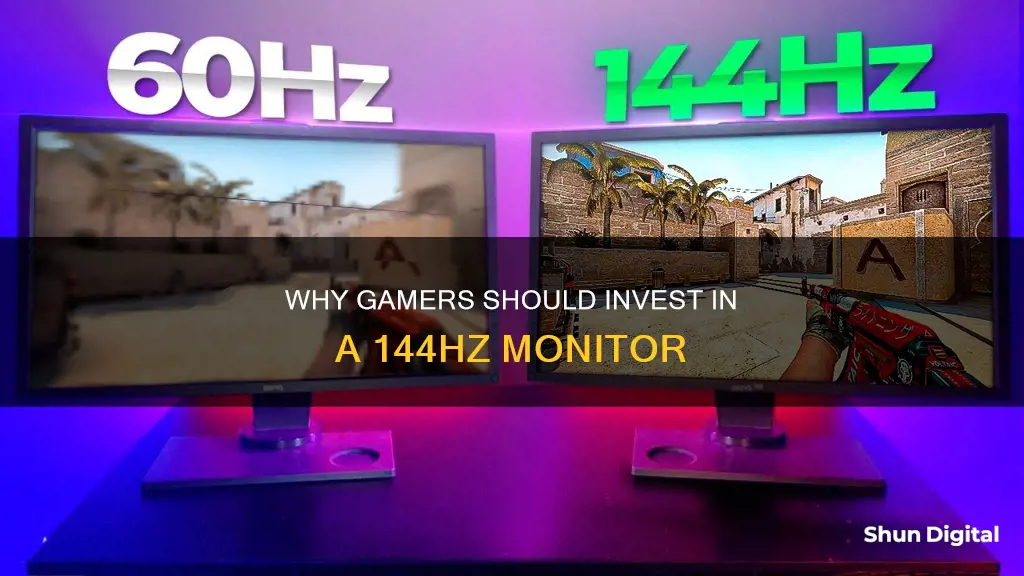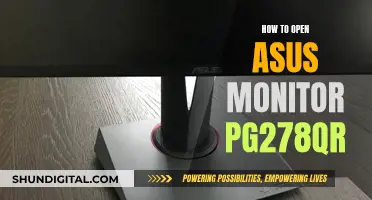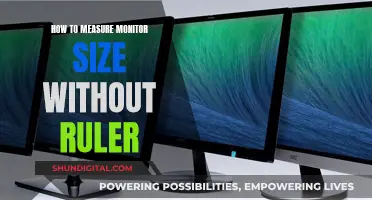
If you're a gamer, a 144Hz monitor is a must-have. It will make your games a lot smoother, and you'll also notice the difference when moving your cursor or scrolling through web pages. However, to take full advantage of a 144Hz monitor, you need to make sure your GPU can output a high frame rate. If your GPU is only managing 50 FPS, you won't be able to utilise the 144Hz refresh rate. You'll need a modern graphics card that can output 144fps to take advantage of a 144Hz monitor.
| Characteristics | Values |
|---|---|
| Smoother gameplay | Yes, especially for shooters and e-sports titles |
| Better for competitive gaming | Yes |
| Better for slow-paced, graphically-oriented games | No |
| Cost | Not much pricier than 60-75Hz monitors |
| Requires | A strong enough CPU/GPU to handle the refresh rate |
| Response time | 1ms or faster GtG response time speed is preferable |
| Variable refresh rate technology | FreeSync for AMD cards, G-Sync for Nvidia cards |
What You'll Learn
- A 144Hz monitor is great for shooters and fast-paced games
- You need a graphics card that can output 144fps to take advantage of 144Hz
- A 144Hz monitor is not necessary if you play slow-paced, graphically-oriented games
- A 144Hz monitor is worth it if you can find one at a similar price to a 60Hz model
- A 144Hz monitor will be a waste if your GPU can't keep up with the monitor's refresh rate

A 144Hz monitor is great for shooters and fast-paced games
A 144Hz monitor is a great choice for gamers, especially those who enjoy shooters and fast-paced games. The higher refresh rate of 144Hz provides a smoother gaming experience, reducing input lag and making your games more responsive and immersive. This is a significant advantage in competitive gaming, where every millisecond counts.
In first-person shooters, for example, a 144Hz monitor can give you an edge over your opponents. It allows you to track moving targets more accurately, as the display refreshes frames more quickly than a standard 60Hz monitor. This means you can react faster and improve your kill/death ratio.
Even outside of gaming, a 144Hz monitor offers benefits. Scrolling through web pages and moving your cursor will feel more fluid and enjoyable. The difference is noticeable, and once you experience it, it's hard to go back to a lower refresh rate.
However, to fully utilise a 144Hz monitor, your graphics card and CPU need to be able to keep up. Your GPU should be able to output a frame rate that matches the monitor's refresh rate; otherwise, you won't see the full benefits of the higher refresh rate. Additionally, a monitor with a fast response time, such as 1ms, is crucial to ensuring smooth motion clarity and preventing motion blur or ghosting.
If you're a fan of shooters and fast-paced games, a 144Hz monitor will elevate your gaming experience. Just ensure that your system specifications meet the requirements to take full advantage of the higher refresh rate.
Bigger Monitors: Better Quality or Just Enlarged Pictures?
You may want to see also

You need a graphics card that can output 144fps to take advantage of 144Hz
If you want to take full advantage of a 144Hz monitor, you'll need a graphics card that can output 144fps. The monitor's refresh rate and the graphics card's frames per second must align for optimal performance. A 144Hz monitor can display 144 frames per second, so to match this, your GPU must be able to output a frame every time the monitor refreshes.
The source (GPU) is as important as the display. If your GPU can only manage 50 FPS, you will only see 50 FPS on your monitor, even if it has a 144Hz refresh rate. To truly leverage the monitor's capabilities, your GPU's output must match.
The GPU's processing power, or how fast it can render a frame, is a key factor in achieving higher frame rates. The more processing power a GPU has, the more frames it can render per second. Additionally, the GPU's performance is influenced by the amount of detail it is asked to render. The higher the resolution and the more complex the game settings, the more detail the GPU has to process, impacting the frame rate.
To summarise, for a seamless visual experience, ensure your graphics card can output 144fps to match your monitor's 144Hz refresh rate.
Monitoring Memory Usage: A Guide for PFsense Users
You may want to see also

A 144Hz monitor is not necessary if you play slow-paced, graphically-oriented games
A 144Hz monitor is a monitor with a refresh rate of 144 times per second, or 144 frames per second (FPS). This is more than double the standard monitor refresh rate of 60Hz. A higher refresh rate means a smoother experience, with less motion blur and screen tearing. This is especially beneficial for fast-paced, competitive gaming, where a high refresh rate can give you a competitive edge.
However, a 144Hz monitor is not necessary for all types of gaming. If you primarily play slow-paced, graphically-oriented games, you may not need the high refresh rate that a 144Hz monitor offers. In this case, investing in a higher-resolution display may be a better option. A higher resolution will provide better picture quality and more detailed visuals, which can be more important for games that focus on graphics and storytelling rather than fast-paced action.
Additionally, to take full advantage of a 144Hz monitor, you need a powerful enough CPU and GPU to support high frame rates. If you have a weak GPU, you may not be able to achieve the high frame rates necessary to utilize the full potential of a 144Hz monitor. This means that, in addition to the cost of the monitor itself, you may also need to invest in upgrading your hardware, which can be expensive.
Therefore, if you play slow-paced, graphically-oriented games, a 144Hz monitor may not be necessary. Instead, consider investing in a high-resolution display to enhance your gaming experience.
Monitoring Wattage Usage: Total Control Over Energy Consumption
You may want to see also

A 144Hz monitor is worth it if you can find one at a similar price to a 60Hz model
A 144Hz monitor is a significant upgrade from a 60Hz monitor, especially for those who play competitive games. The higher refresh rate makes video games a lot smoother and improves gaming responsiveness and immersion. It also makes moving your cursor around and scrolling through web pages more fluid and enjoyable.
However, to take full advantage of a 144Hz monitor, your graphics card needs to be able to output a high number of frames per second (FPS). For example, if your GPU can only manage 50 FPS during gameplay, you will only see 50 FPS on your 144Hz monitor. Therefore, it is important to ensure that your GPU can keep up with the monitor's refresh rate.
If you are mainly into slow-paced and more graphically-oriented games, a higher resolution display might be a better option. However, if you can find a decent 144Hz monitor at a similar price to a 60Hz model, it is definitely worth considering. You will notice a significant improvement in smoothness and responsiveness, even when performing everyday tasks such as moving your cursor or scrolling.
Additionally, if you plan to upgrade your PC in the future, a 144Hz monitor will be a worthwhile investment. It will allow you to take full advantage of the improved performance without needing to replace your monitor again.
Selecting a Monitor: Guide to Directing Program Displays
You may want to see also

A 144Hz monitor will be a waste if your GPU can't keep up with the monitor's refresh rate
A 144Hz monitor is a great option for gamers, especially those who play fast-paced games such as shooters. It provides a smoother experience and can improve your performance in competitive gaming. However, to fully utilise the high refresh rate of a 144Hz monitor, your GPU must be able to keep up in terms of frames per second (FPS). If your GPU cannot consistently output a high FPS, you won't be able to take full advantage of the 144Hz monitor.
The 144Hz monitor itself only dictates how many frames it can display, but if your GPU is only outputting 50 FPS, for example, you will only see 50 FPS on your monitor. Therefore, it is crucial to ensure that your GPU can handle high frame rates to match the monitor's capabilities. If your GPU cannot keep up, you may experience screen tearing or input lag, which can negatively impact your gaming experience.
Additionally, when considering a 144Hz monitor, it is important to look at other specifications as well. For instance, a monitor with a fast response time, typically 1ms or lower, is ideal to prevent motion blur and ghosting. Moreover, technologies like FreeSync or G-SYNC can help synchronise the refresh rate of the monitor with the output of your GPU, reducing screen tearing and improving overall performance.
In summary, while a 144Hz monitor can significantly enhance your gaming experience, particularly in fast-paced and competitive games, it is crucial to ensure that your GPU is capable of delivering high frame rates to match. Upgrading your GPU alongside investing in a 144Hz monitor will ensure that you can take full advantage of the high refresh rate and enjoy a smoother and more immersive gaming experience.
Monitoring Internet Usage: Who's Watching and How?
You may want to see also
Frequently asked questions
A 144Hz monitor provides a smoother experience, not just for gaming but also for everyday tasks like moving your cursor and scrolling through web pages. It also reduces input lag and makes screen tearing less noticeable, improving overall gaming responsiveness and immersion.
Yes, to take full advantage of a 144Hz monitor, you need a graphics card that can output a high frame rate, ideally matching the monitor's refresh rate.
If your PC can't reach 144 FPS, the monitor will still function but at a lower refresh rate. You can also enable VSync to match the monitor's refresh rate to the frame rate output by your graphics card, but this may introduce input lag.
If you're mainly into slow-paced and more graphically-oriented games, consider investing in a higher-resolution display instead. You can also look for a monitor that offers both a high refresh rate and a high resolution, as the price difference between these models and standard 60Hz monitors isn't too significant anymore.







